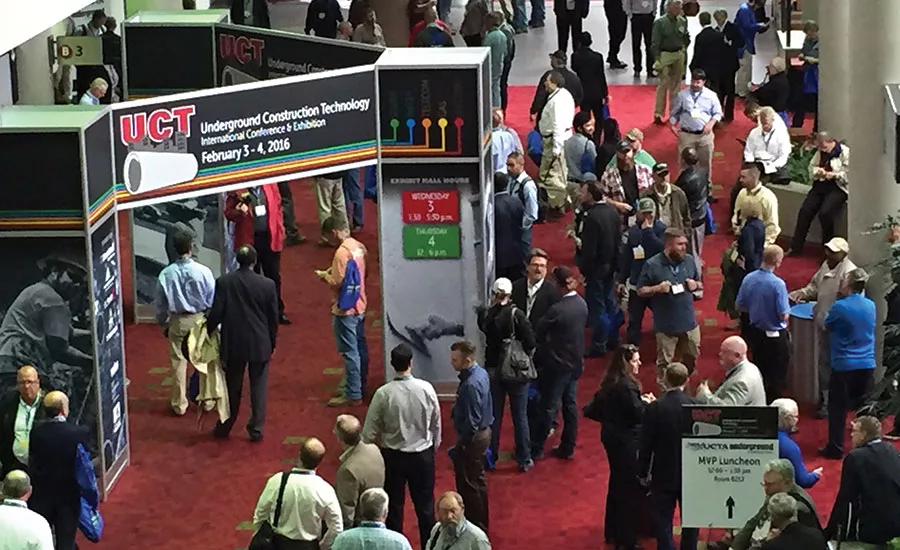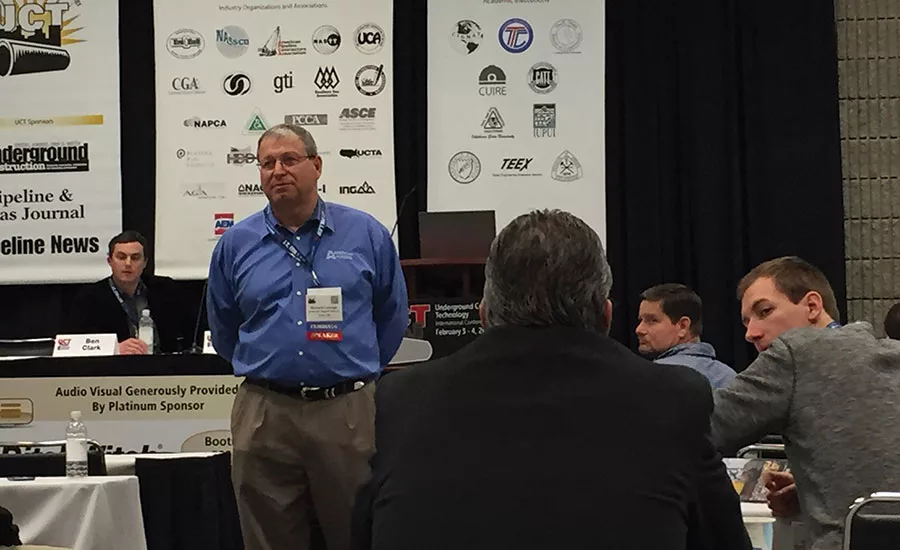Drilling Fluids Expert Offers Advice for HDD Contractors

This year’s Underground Construction Technology International Conference & Exhibition in Atlanta was held in February. Source: Jeremy Verdusco

Richard Levings of American Augers moderated the UCT event’s tract for HDD contractors. Source: Jeremy Verdusco
Contractors in horizontal directional drilling, like in other drilling industries, depend on their fluids management plans to keep current projects moving and new ones coming in. National Driller recently spoke to an expert on the subject, Richard Levings, product development manager with American Augers. Levings moderated the productivity and fluid management tract for HDD contractors at this year’s Underground Construction Technology International Conference & Exhibition in Atlanta. We covered topics ranging from regulation to disposal to the importance of a good cone shaker. Our conversation here is edited for space and clarity.
Q. What makes you qualified to talk about HDD fluids management?
A. Basically, I started in this industry on Jan. 1 of 1990 and that was the beginning of directional drilling — the HDD industry — from a commercial standpoint. So, I grew up in this industry. I’ve been a product manager working with customers and users and engineers developing the equipment as it has evolved since 1995. I’ve worked all around the globe with contractors of every size now, and worked on specific projects. I have been called to consult for projects and troubleshooting and … just 27 years experience.
Q. What kind of disposal mistakes are contractors making that cost them time and efficiency?
A. Well disposal over the last five years has evolved into a very difficult situation for a lot of people. They’re typically working with a very high fluid, where it has a lot of water in it, and most of the disposal sites are easy to find for solid material. But for liquid material, they typically won’t take it or if they do it’s enormously expensive. That has evolved into a very difficult situation for people because they might find a place that will take it, but it might be two hours one way. They may charge them three to six to eight hundred dollars for an 800-gallon vac tank to dispose of that fluid. Those costs are mounting and the contractors aren’t being repaid for that. They’re having to take that out of their margins. And, of course, it’s a highly competitive business these days and so it’s not like what they’re being paid is going up.
Q. So are they failing to build that into their bid prices, or they can’t?
A. In many instances, they can’t. There are some places where they negotiate with the owner to say, “Listen, disposal is really, really difficult. The cost level is this, and you’ve got to find me a place and it’s at your expense.” That happens on some instances. Some of the plant owners, they know this and they will go secure a place within a city or wherever they’re working, they will go secure a place for them to dispose of the fluid. It really depends where you are, who you’re working with, their level of knowledge about the whole process and their dealing and their desire to control the PR, if you will, that is seen in dumping this liquid.
Q. In your presentation, you called the first-cut shaker the primary part of the fluid separation system. Can you talk a little bit about its importance, as opposed to cone shakers or other aspects of the system?
A. The industry, for most of the history of the fluid cleaning industry in the HDD market, has always rated the fluid cleaning systems by the amount of water they can pump through the set of centripetal cones that they use to separate the fine-particle solids. Usually, in a design, you design those cones to handle one and a half times the amount of fluid that the first-cut shaker will take. So, if you say to a contractor, “I have a 750-gallon-a-minute cleaning system,” because that’s what your cones are, but your first-cut shaker will only handle 500 gallons a minute, then that contractor believes, “I can buy this 750-gallon-a-minute fluid cleaning system and pump 750 gallons to it,” and you can’t.
Q. So, in effect, the first-cut shaker is the limiting factor?
A. The first-cut is the limiting factor. What contractors often then have to do is they have to put a coarse screen that lets everything fall through so that they can have enough capacity to pump their pump over there. What happens then is they overload their system with solids and it wears everything out prematurely, they don’t do as good a job at getting solids out and, as I said in my presentation, solids in drilling fluid are evil. They do really bad things to the cleaning system, to the drill, to the borehole — every aspect of the process.
Q. You mentioned WOTUS in your presentation. What is that and why should it concern HDD contractors?
A. WOTUS stands for “waters of the U.S.,” and it is an EPA (Environmental Protection Agency) and Army Corps of Engineers rule that gives them control over all of the water systems in the entire United States — and when I say water systems, I mean all of the watersheds. … In other words, the federal government will gain control over what happens on as much — it appears from the map — where it could be 85 percent of the landmass of the lower 48 and Alaska. It’s going to heavily affect the agricultural industry, and our industry leans on the agricultural industry to be able to land spread directional drilling fluids.
There have been studies done that show that land application is a viable alternative for them [HDD contractors]. If WOTUS goes through, that is taken off the table. Furthermore, because it is being wrapped into the Clean Water Act, there will be no disposal where any of those things could leak into any of these watersheds because of the Clean Water Act. It’s a complicated situation, but it is on the table. Right now, it is blocked by the courts, but that’s not forever.
Q. So what are the disposal options if that passes, if that clears the courts?
A. It will become very limited. I can’t sit here and tell you that I know exactly where we will wind up if that passes. It is something that could, overnight, affect us dramatically in this industry. And so we need to have our eyes on it, be paying attention to it and understand what may come our way.
Q. What should contractors know about sizing a fluid separation system before they go out and buy one or lease one?
A. That the industry and the way that industry rates fluid systems can be misleading. They need to understand how much fluid they’re going to pump, how big of a hole they’re going to cut, how much fluids and what kinds of solids they’re going to bring back, and size that first-cut shaker to be able to handle those solids — that amount of solids — and get as much out of that first-cut as they possibly can. That’s the first thing they need to understand. Second of all, they need to understand what their piping sizes are. They need to understand what the design of the cones are and the cone pumps because, oftentimes in order to make these things cheaper, people will use a smaller pump and so you don’t get the right pressure in those cones. Those cones are highly dependent upon the correct pressure and flow so that they can be efficient enough to separate the small-particle solids. The first-cut shakers are removing the big stuff. The cone shakers are removing the smaller-particle stuff so that you can get it back into a workable, low solids drilling fluid. So, it’s a combination of all of those things.
We at American Augers would say that you need to pay more attention to the noise level that these systems create, because many of the directional drilling systems are no longer working in rural areas. They’re working in downtown, they’re working in urban areas or working in suburban areas. The noise pollution is very relevant. You know, it may get to a point where they can’t work on a project if their equipment is not below a certain decibel level. We have redesigned almost our entire fluid cleaning systems product line, and all of them have quiet pack equipment on them so that we can work in those noise-sensitive environments.
Q. Do you see any common skills gaps in up-and-coming mud techs and, if so, what would those be?
A. I think it’s more of a lack of focus from the general population of contractors, not realizing how much money a fluid cleaning system can make them, save them, or how much it can cost them if they don’t properly staff and train and keep attention to and focus on the entire fluids side of their business. I guess we’ve learned that we’d kind of like to start with a brand new operator to train, because we can train them properly, correctly and to follow all of the things, because a lot of guys have received no training or trained improperly. I think as an industry we’ll start seeing more training opportunities and more focus on this, and it will make it easier for people to gain more in-depth, better knowledge and see that technology is moving forward, that the designs are getting better and that the equipment that we will be utilizing will be able to more effectively clean fluids.
Q. We had talked about the waters in the U.S. but are there other important issues that contractors need to consider in the next five or 10 years when it comes to fluid recycling, solids management, that kind of thing?
A. The fact that, you know we don’t know where we are in terms of traffic regulations. Is it such that they’re regulated in some way, shape or form of moving throughout the day or certain periods of time of the day? I think we’re already seeing periods of the day that are off limits to contractors because of either traffic and/or noise issues and that sort of thing. So, I think that will only get more difficult for them.
You know, it kind of remains to be seen the fallout of things like Flint, Mich., with the lead thing. How much spotlight now is shined on anything with people using fresh water? Are we going to go overboard in terms of regulating how we can acquire water, where we can take it to, how does it then interact with the environment and be returned back to water? And so we’ll have to watch that fairly close because things like Flint can bring light to a lot of different things.
Q. At the same time, it can create work, but also sheds attention.
A. Attention and regulation.
Q. So you mentioned in your presentation the term “visual prosecution.” What is that and how does it affect contractors?
A. Visual prosecution is when the general public, who is not aware of what directional drilling fluid is — and let’s revisit what directional drilling fluid is in our industry. It is bentonite, which is Wyoming clay mined to be a directional drilling fluid. It is sometimes a surfactant, which is a soap that is a phosphate. In the agriculture business we use phosphorous for fertilizer, and that’s all this is. The polymers that we might use is polyacrylamide. Those are often used as a soil stabilizer on bare soil to keep it from running off and eroding. Then the last thing is soda ash, which is sodium bicarbonate, and all it is the pH balancer. It’s those four items. So everything in there is naturally appearing, inert products, but because the general public is uneducated as to what directional drilling fluid is, they see this fluid that’s not clear water, and it automatically is contaminated in their minds. But it’s perfectly clean. They see these specialized vac trucks or vessels that are carrying this fluid off, and as far as they know it’s going to a toxic dump. So, with no information, they assume that it’s harmful. They do that with their eyes. So they visually prosecute these guys, and they don’t want anything. … They don’t want anything in their yard. … They don’t want him working around those areas and what not.
I say all of that so that contractors are cognizant of the fact that people are watching every move they make, and if they’re proactive and go out and educate the neighborhoods that they’re working in: “This is what this is. Here’s a pamphlet.” … We could get them information about what this is that they can hand out. I think DCA actually is working on some further studies on this. But they can educate those people and get ahead of that so that the visual prosecution doesn’t happen. When visual prosecution happens, delays in projects often happen.
Q. So in that aspect, do you think people are equating the much shallower HDD kind of work with oil and gas fracking, that sort of thing?
A. Absolutely, yes they do. And that is one of the things in the — I mentioned the Ditch Witch study, they worked with Oklahoma State University. When Oklahoma State put out their fact sheet … that’s one of the first things they state: This is not oil and gas directional drilling fluid. With the national debate on the oil and gas industry and fracking and all of those things, that’s at the peak of most people’s interest and they associate this with it. Contractors need to get ahead of that in order to mitigate that risk.
Looking for a reprint of this article?
From high-res PDFs to custom plaques, order your copy today!


